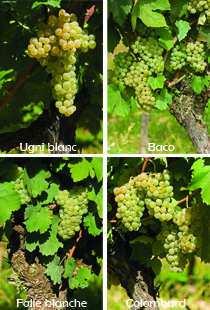Grape varieties and Terroirs

The terroirs
Bas Armagnac, Armagnac Tenarèze and Haut Armagnac together constitute a vineyard in the form of a vine leaf that represents 20 000 hectares of vines planted (shared with the IGP Côtes de Gascogne and PDO Floc de Gascogne, of which today, 5200 hectares are identified exclusively for the production of Armagnac) over a part of the three departments: The Gers, the Landes and the Lot-et-Garonne.
The climate is temperate and gentle. The humid oceanic influence reduced by the Landes forest is particularly noticeable in the west of the Appellation. To the east, it is the Mediterranean climate that has an impact with the southerly winds.
- Bas Armagnac to the west is rolling countryside; the vines grow on poor and acidic clay loam soils with pockets of iron elements in places that colour it reddish brown, hence their name ‘tawny sands’. The ‘boulbènes’, characteristic sediment in the region are predominantly silty soils. This zone produces light, fruity, delicate and highly reputed eaux-de-vie.
- Armagnac Ténarèze in the centre is a transitional zone. Here we find ‘boulbènes’ and ‘terreforts’ (Gascon name given to clay-limestone soils that are heavy yet fertile). These eaux-de-vie are generally more full-bodied. They reach their peak after a long ageing.
- Haut Armagnac in the south and east is very spread out. The hills are of limestone and clay-limestone whilst the valleys are sometimes covered with boulbènes. The vineyards here are quite sparse.
The vine
In terms of grape varieties, the diversity and the adaptation to the terroir are the rule.
 Among the ten grape varieties authorised for the production of Armagnac, four main ones give their personality to the eau-de-vie:
Among the ten grape varieties authorised for the production of Armagnac, four main ones give their personality to the eau-de-vie:
- Ugni-blanc is the distillation grape par excellence. It gives acidic and low alcohol wines that after distillation produce fine eaux-de-vie of high quality. This variety is well adapted to all of the Armagnac terroirs.
- Folle Blanche is the best known. It is the historical grape variety for Armagnac that dominated the vineyards before its destruction by phylloxera in 1878 and at that time it was called " piquepoult ". Today, its cultivation on rootstock is more difficult and it is quite rare. Folle Blanche produces fine and often floral eaux-de-vie with great elegance that is particularly valued in Blanche or young Armagnacs.
- Baco (previously called « Baco 22A ») is an originality in the French winegrowing landscape. It is a hybrid, being the son of Folle Blanche and Noah and invented by a Landes schoolteacher, Monsieur Baco following phylloxera. It is particularly adapted to the sandy soils of the Bas-Armagnac that give the eau-de-vie roundness, smoothness and aromas of ripe fruits, particularly after long ageing. Apart from its organoleptic richness, Baco today has more advantages: it is a robust variety and therefore needs less phytosanitary treatments which is another reason why the profession has worked to ensure that it permanently stays in the appellation’s specifications (it was previously destined to disappear in 2011), and was officially recorded in 2005 during the revision of the specifications for AOC Armagnac.
- Colombard is today used and valued in the vinification of the Côtes de Gascogne wines. Its distillation is more rare; its fruity and spicy aromas are appreciated in blends.
- Blanc Dame, Jurançon blanc, Graisse, Meslier Saint François or Mauzac blanc and rosé are all old varieties that are just represented today by a few hectares of vines even though certain ones are being replanted by some producers that wish to preserve the heritage and historic diversity of Armagnac.
Natural vinification
The grapes harvested in the month of October are pressed and the juice is left to ferment naturally without the addition of any oenological products. The wine is generally low in alcohol and quite acidic; it therefore has a good capacity to retain all of its freshness and aromas until the distillation.
The INAO, from the plot to the barrel
If the world’s alcohols have often become industrial products, Armagnac is committed to strengthening its position as a wine eau-de-vie registered in a terroir and its uses; in one word, an AOC of the vine and the wine. This concern associated with the redesign by the INAO* of the agreement conditions, has driven the profession to reflect, negotiate, approve and now apply the new rules for monitoring, control and approval of the production by the INAO.
It is the identification of the production tools: plots, alambics and cellars that are the basis of this monitoring, each is appraised according to the specifications drawn up in consultation with the profession. New conditions of approval strengthen the quality control.
- Armagnac comes from a plot of vines cultivated in a specific way on the appropriate terroir. The plot identification of each estate details the plots destined for Armagnac.
- Armagnac is distilled using a traditional artisanal size alambic. The identification of the alambics certifies that the capacities, number of plates… is consistent with the uses and appellation laws.
- Armagnac is aged in appropriate cellars where the ageing conditions (quality of the oak, capacity of the containers, buildings, aeration…) are certified by the cellar identification. Armagnac is quality controlled in the first year of ageing, in order to separate any eaux-de-vie that do not deserve the Appellation. This is the product control by the INAO.
- Everyone is well convinced that these controls are not the only argument for sales as they also reinforce the seriousness of the profession, the traceability of production and ultimately the quality of the Armagnacs.
* INAO: Institut National de l'Origine et de la Qualité (National Institute of Origin and Quality)

NB: Unlike appellation wine, Armagnac has not passed into PDO (Protected Designation of Origin), as it does not apply to spirits at the moment. Armagnac therefore remains an AOC.


